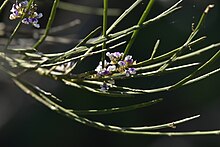| Athrips zophochalca | |
|---|---|
 | |
| Illustration of male | |
 | |
| Illustration of female | |
| Scientific classification | |
| Domain: | Eukaryota |
| Kingdom: | Animalia |
| Phylum: | Arthropoda |
| Class: | Insecta |
| Order: | Lepidoptera |
| Family: | Gelechiidae |
| Genus: | Athrips |
| Species: | A. zophochalca |
| Binomial name | |
| Athrips zophochalca | |
| Synonyms [2] | |
| |
Athrips zophochalca is a moth of the family Gelechiidae. [1] It was described by Edward Meyrick in 1918 and is endemic to New Zealand. A. zophochalca has been observed in both the North and South Islands as well as at the Poor Knights. The species inhabits scrubby native forest, saline wetlands and braided river habitat. Larvae bore into the terminal shoots of Carmichaelia species. Adults are on the wing from November until March and are sexually dimorphic with the male lacking the white band on the forewings.
